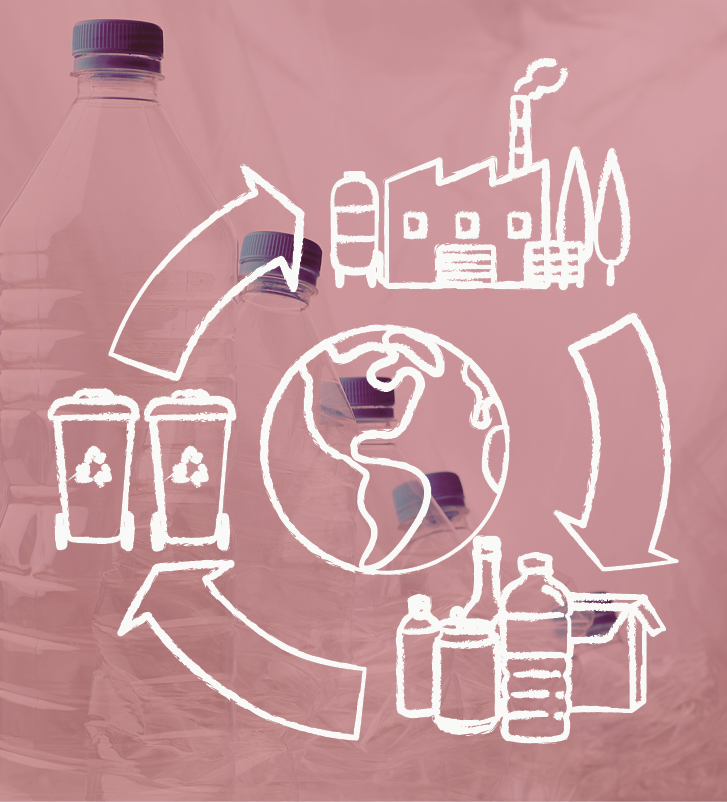The digital twin for a sustainable circular economy
Discover the possibilities of the digital twin for a sustainable circular economy. By extending the lifespan of products and resources and returning them to the end-of-life cycle, we are helping to minimise waste, protect resources and reduce harmful emissions. Find out how the digital twin as a digital foundation enables ever more sustainable value creation.

PET bottles have become an integral part of many households: they are light, hygienic, and extremely practical. However, they also impressively illustrate the challenges of a sustainable circular economy.
The vision is clear: once they have been returned, old PET bottles should be turned into new ones to create a closed recycling loop. However, this goal is threatened by the phenomenon of “downcycling”. Instead of new bottles, products such as textiles or tyres are often made from old plastic bottles. Re-use for the production of food containers is ruled out.
For manufacturers, this means a deterioration in their carbon footprint: if no recycled PET material is available, they have to resort to new material and corresponding resources. This increases the carbon footprint compared to a closed cycle from bottle to bottle.
Circular economy: more than just recycling
This example illustrates that the circular economy goes far beyond simple recycling by fundamentally changing production and material flows.
Instead of discarding or downgrading products at the end of their useful life, the circular economy strives to utilise materials for as long as possible and continuously return them to the cycle. This is more environmentally friendly, as the actual reprocessing of materials and components often requires less energy than recycling. The latter reduces the consumption of resources, minimises waste and lowers the environmental impact.
The European Union has recognised the importance of the circular economy and addressed it in the taxonomy of the circular economy as part of the EU's Green Deal in order to drive forward the climate transition and reduce the extraction of raw materials.
The transition to a circular economy is fundamentally changing the manufacturing and distribution processes of companies. Instead of linear flows of goods, complex processes are now emerging in which products are taken back and reused.
How can sustainability be assessed?
Sustainable action in a circular economy is extremely multifaceted. Clear and precise information is essential for making informed decisions. Digital twin technology is proving to be extremely useful here, especially when it comes to assessing sustainability. This is a precise 1:1 digital replica of physical products over their entire life cycle.
In episode 2 of the msg podcast “radikal digital”, Dr Wolfgang Bock and Dr Stephan Melzer discuss the many possible applications of the digital twin and explore the question of what potential it offers, particularly in the areas of climate management and crisis prevention.
Looking at the entire value chain
The digital twin offers a comprehensive insight into the entire value chain. For example, it can record and manage all emissions data generated during the product life cycle: from development to the raw materials and materials used for production through to distribution, utilisation and finally recycling in a circular economy.
Within this cycle, all companies in the supply chain must determine their share of the carbon footprint of the end product and make it available in order to calculate the product carbon footprint (PCF). The PCF is lower if recycled materials are used for production. Due to increasing regulatory requirements, companies are also obliged to state exactly whether the parts used in their products are recyclable. Here too, the digital twin can provide precise information on the wear and tear and service life of products.
The connected digital twin
The potential of the digital twin is enormous, but its full impact can only be realised if it is used in a networked and cooperative manner. In a circular economy, it is no longer expedient to think in terms of data silos. All necessary data sources must be seamless, purpose-orientated and integrated across all relevant areas. The basis for the success of the networked digital twin is continuous data permeability. Data exchange must not be one-sided: All companies along the supply chain must be able to contribute and receive data to enable a more sustainable design of their products.
The digital twin as open source technology
In order for the digital twin to be used jointly, the data must above all be recorded and processed in a standardised manner. Similar to the standardisation of containers in maritime transport in the 1950s, which enabled ships to be loaded much more quickly, cross-industry data standardisation is now required.
Asset Administration Shell
In the manufacturing industry, the Industrial Digital Twin Association (IDTA) is committed to the joint development of a standardised digital twin based on the Asset Administration Shell (AAS).
The aim is to establish the digital twin for components, machines and entire factories as an open source technology. Through open standards, the AAS enables a cross-platform exchange of information between different manufacturers. In this way, the AAS makes a valuable contribution to climate protection and the promotion of a future circular economy.
The basis for an effective circular economy
When multiple companies share an interoperable digital twin and data is captured in a standardised way while secure data rooms are in place, this forms the basis for an effective circular economy. This innovative approach not only increases efficiency, but also makes a sustainable contribution to environmental protection. A shared, interoperable digital twin thus lays the foundation for a forward-looking and environmentally friendly business world.
Together in a virtual data room
Digital twin technology proves to be particularly valuable when it is used jointly by several companies. It is therefore of great importance that all partners involved in product development have access to a virtual data room. These data rooms provide a secure infrastructure for data exchange in which the partners can work together while maintaining data sovereignty.
The Gaia-X initiative plays a key role in this context by creating data ecosystems for various industries. In the automotive sector, for example, the Catena-X initiative focuses on connecting companies in the automotive industry along the entire value chain.


